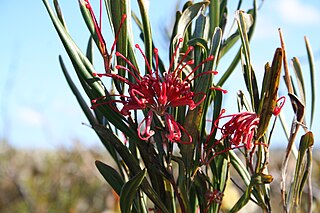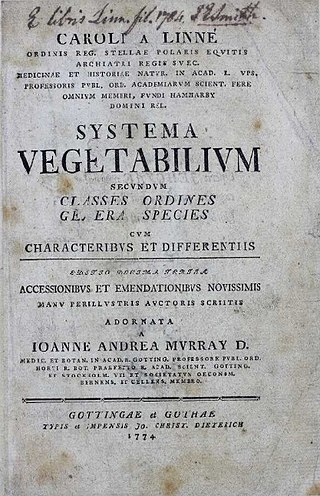
The archbishop of Cologne governs the Roman Catholic Archdiocese of Cologne in western North Rhine-Westphalia. Historically the archbishop ruled a state of the Holy Roman Empire and was ex officio one of the prince-electors, the elector of Cologne, from 1356 to 1801.
Georg Hermes was a German Roman Catholic theologian who advocated a rational approach to theology. During his lifetime, his theology was greatly in vogue in Germany, but declined after the posthumous papal condemnation of "Hermesianism" by Pope Gregory XVI.

Josef (Joseph) August Schultes was an Austrian botanist and professor from Vienna. Together with Johann Jacob Roemer (1763–1819), he published the 16th edition of Linnaeus' Systema Vegetabilium. In 1821, he was elected a foreign member of the Royal Swedish Academy of Sciences. He was the father of Julius Hermann Schultes (1804-1840).
Julius Hermann Schultes was an Austrian botanist from Vienna. He co-authored volume 7 of the Roemer & Schultes edition of the Systema Vegetabilium with his father Josef August Schultes (1773-1831).

The Metropolitan Archdiocese of Paderborn is a Latin Church archdiocese of the Catholic Church in Germany; its seat is Paderborn. It was a diocese from its foundation in 799 until 1802, and again from 1821 until 1930. In 1930, it was promoted to an archdiocese. From 1281 until 1802, the Bishopric of Paderborn was also a state of the Holy Roman Empire.

William Theodore Schulte was an American politician who served five terms as a U.S. Representative from Indiana from 1933 to 1943.

Grevillea oleoides, also known as red spider flower, is a species of flowering plant in the family Proteaceae and is endemic to eastern New South Wales. It is an erect shrub with egg-shaped leaves, the narrower end towards the base, sometimes elliptic or linear leaves and red or reddish-pink flowers usually within the foliage.

The Archdiocese of Cologne is a Latin Church archdiocese of the Catholic Church in western North Rhine-Westphalia and northern Rhineland-Palatinate in Germany.
Schultes is a surname. Notable people with the surname include:
Francis Bible Schulte, O.H.S. was an American prelate of the Roman Catholic Church. He served as archbishop of the Archdiocese of New Orleans in Louisiana from 1989 to 2002.
Schult is a German surname. Notable people with the surname include:
The Kölner Werkschulen, formerly Cologne Art and Craft Schools, was a university in Cologne training artists in visual arts, architecture and design from 1926 to 1971.

Wilibald Swibert Joseph Gottlieb von Besser, known in Russia as Vilibald Gotlibovich Besser was an Austrian-born botanist active in former eastern territories of Poland occupied by the Russian Empire, who worked most of his life within today’s territory of western Ukraine.

Persoonia myrtilloides, commonly known as myrtle geebung, is a plant in the family Proteaceae and is endemic to New South Wales. It is an erect to spreading shrub with elliptic to egg-shaped leaves and yellow flowers in groups of up to forty on a rachis up to 170 mm (6.7 in) long.

Persoonia acerosa, commonly known as needle geebung, is a species of flowering plant in the family Proteaceae and is endemic to a restricted area of New South Wales. It is a shrub with small, channelled, needle-like leaves, yellow tubular flowers and yellowish-green, pear-shaped fruit.

Petrophile sessilis, known as conesticks, is a species of flowering plant in the family Proteaceae and is endemic to New South Wales. It is an erect shrub with rigid, needle-shaped, divided, sharply-pointed leaves, and oval, spike-like heads of silky-hairy, creamy-yellow flowers.

Gagea liotardii is a Eurasian and North African species of plants in the lily family. It is a bulb-forming perennial up to 15 cm tall. Flowers are generally bright yellow to yellow-green. Its native range stretches from Spain and Morocco to Mongolia.

Allium subvillosum, the spring garlic, is a European and North African species of wild onion native to southern Iberia, the Balearic Islands, Sicily, northern Africa and the Azores where it might be introduced.

Ipomoea polymorpha is a morning glory species that was first described by Swiss botanist Johann Jacob Roemer and Austrian botanist Josef August Schultes. It is endemic to Australia.

Systema Vegetabilium is a book published in four editions, following twelve earlier editions known as Systema Naturae. The first edition, published in 1774 and edited by Johan Andreas Murray is counted as edition 13 because it continues from the 12th edition of Systema Naturae. All the names in it are attributed to Carl Linnaeus. The second edition, published in 1784, includes plant species described by J.A. Murray and Carl Peter Thunberg. The third edition was edited by Christiaan Hendrik Persoon.














